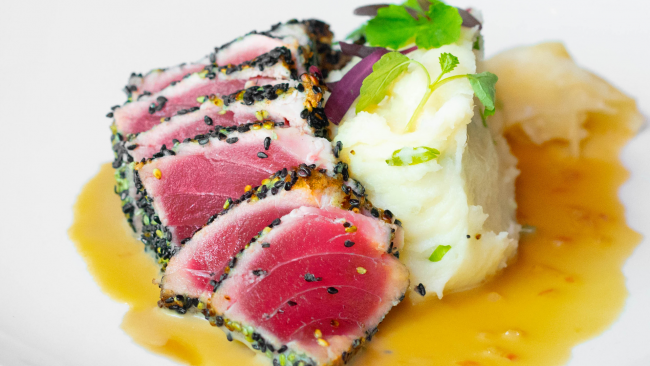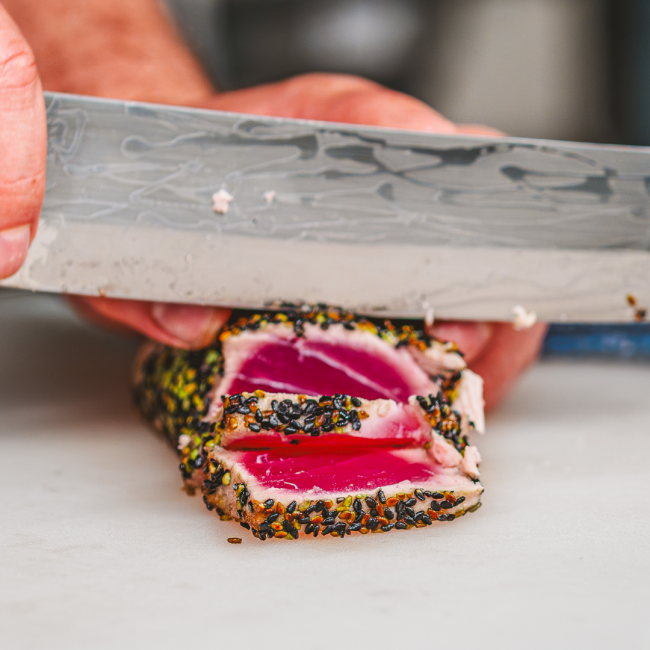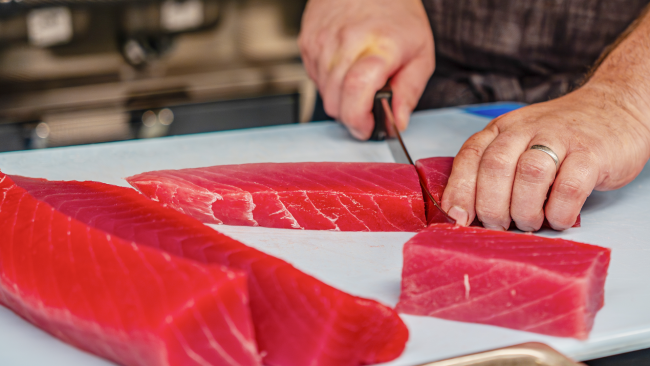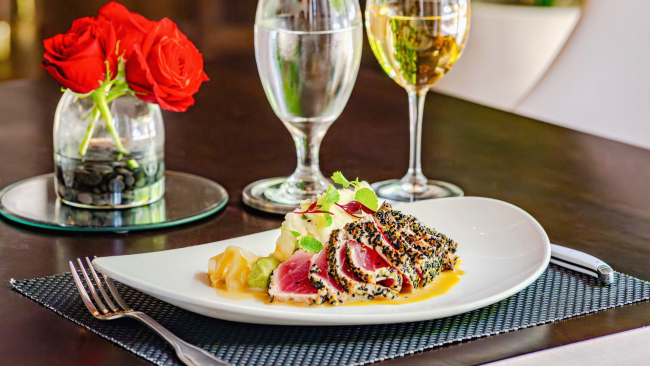At Truluck’s, we pride ourselves on sourcing and serving only the finest the oceans have to offer, and our tuna is a testament to this commitment. Bringing the highest-quality, most flavorful fish to our guests requires a deep knowledge and respect for sustainable fishing practices, different methods of catching tuna, as well as proper grading, handling, and cooking. Let’s dive into the wide world of fresh tuna and emerge with an even greater appreciation for this extraordinary fish.

Fishing
Responsible fishing of yellowfin and bluefin tuna typically involves practices that prioritize sustainability and minimize negative impacts on the environment and fish populations. Our fishing partners dutifully adhere to catch limits set by regulatory bodies, use specialized fishing gear to reduce bycatch of non-target species, and avoid fishing in sensitive areas or during critical reproductive periods.
Supporting fisheries that are certified by organizations like the Marine Stewardship Council (MSC) or the Aquaculture Stewardship Council (ASC) ensures that the fish are sourced from sustainable, well-managed operations. Our long-standing relationships with these principled, passionate purveyors enable us to continue serving the freshest, most flavorful tuna to our guests year after year.

Grading
Fresh tuna can receive grades of #1 (highest quality), #2+, #2, and #3, based on several key factors. The process may vary depending on region and specific market standards, but these are some common grading criteria:
Color — Color is an important factor in the grading process and an immediate indication of the fish’s quality, freshness, and flavor. High-quality tuna typically has vibrant red flesh. Yellowfin tuna, for example, is prized for its bright red color, while bluefin may have a darker red hue.
Fat Content — The amount of fat affects the tuna’s flavor, tenderness, and overall quality. Tuna with a higher fat content, particularly with marbling throughout the flesh, is often considered more desirable, as it tends to be more flavorful and tender.
Texture — High-quality tuna should have firm, dense flesh that holds together well when cooked. It should not feel mushy or soft to the touch.
Size and Shape — A tuna’s size and shape may also play a role in grading, particularly if there are specific market preferences for certain cuts or preparations. Larger fish typically have a higher fat content.
Overall Appearance — This includes freshness, cleanliness, and the absence of any blemishes or defects.
Industry organizations, regulatory bodies, or individual marketplaces set these standards to ensure consistency and quality. Trained professionals, such as seafood inspectors or buyers, assess and grade the tuna based on the established criteria. At Truluck’s, our discerning buyers are well versed in these grading standards and select only the finest fresh tuna for our restaurants.

Handling
To ensure the best taste and quality and prevent foodborne illness, follow these steps for safely preparing fresh tuna at home:
Buy — Always purchase fresh tuna from a trusted fishmonger or a seafood market with a good reputation for quality and cleanliness.
Store — Tuna should be consumed as close to catch as possible. If not cooking immediately, store tuna in the refrigerator at or below 40°F (4°C) and use within 1-2 days of purchase.
Handle — Wash your hands thoroughly with soap and water before and after handling raw tuna to prevent cross contamination. Use separate cutting boards and utensils for raw seafood to avoid contaminating other foods.
Inspect and Clean — Before cooking, inspect the tuna for any signs of spoilage, such as an off odor, sliminess, or discolored patches. Rinse the tuna under cold water and pat it dry with paper towels.

Cooking
Tuna can be prepared many ways, but the purest approach is to enjoy it raw or to quickly sear the surface and leave the tuna rare to medium rare in doneness. Grilling, broiling, or roasting are also great ways to prepare fresh tuna; just be careful not to overcook. Aim for a warm red center for optimal flavor and texture. After cooking, our chefs recommend you keep it simple and finish with a spritz of citrus to accentuate the flavors of the fish. A splash of soy or a sprinkle of good olive oil also work beautifully, complementing the natural fat in the fish without masking its flavor.

At Truluck’s, we take the same simple approach and let the unmatched quality and freshness of our tuna speak for itself. Our iconic Ahi Tuna Tartare and Seared Sesame Tuna offer two distinctively delicious ways to enjoy this remarkable fish. It’s no wonder they’ve become mainstays on our menu and beloved by generations of diners. Try them both and experience the true essence of one of the ocean’s greatest gifts. Your table is waiting.


 OCEAN'S FINEST SEAFOOD & CRAB
OCEAN'S FINEST SEAFOOD & CRAB

